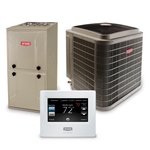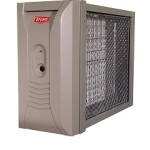An Ounce of Prevention
Carbon monoxide (CO) gas kills more than 500 people every year in the United States. It’s odorless and colorless, so you won’t know you’re inhaling it. Although the level of CO in most homes is not harmful, be concerned if you have any of these symptoms:
■Headache
■Dizziness
■Weakness
■Vomiting
■Chest pain
■Confusion
If you experience these symptoms while you’re inside, open all the windows, turn off all fuel-burning appliances, and get out of the house. Go to the emergency room or call 911 if the symptoms are severe. Tell the doctors or emergency medical technicians that you think you may have CO poisoning.
When you return home, keep the windows open and call a heating, ventilation, and air conditioning (HVAC) contractor and ask him or her to come to your home and check for leaks in your HVAC system, especially if your furnace is gas- or oil-fired. Call other professionals who can check your stove, fireplaces, and space heaters.
What you can do to protect yourself and your family
Any heater or motor that burns natural gas, gasoline, coal, kerosene, diesel fuel, or charcoal can leak carbon monoxide. If a furnace or other appliance or a car or truck that burns one of these fuels is not vented properly, CO can build up inside your home or vehicle.
In your home:
■Install a carbon monoxide detector in your house. Check the battery every time you check your smoke-detector batteries, twice a year. A good way to remember is to do this when daylight savings time begins and ends or the first day of spring and fall.
■Every year, have an expert inspect and service all of your fuel-burning appliances, such as your furnace, gas water heater, fireplaces, gas stove, or portable butane or kerosene heater.
■Never burn anything in an improperly vented stove or fireplace, never burn charcoal indoors, and never use a gas oven to heat your house. Such actions can cause carbon monoxide to build up.
■If your home’s electric power goes out, you may need to use an alternate source of heat. Never use grills, camp stoves, or other gasoline- or charcoal-burning devices inside your home or garage. Do not run a gasoline-powered generator in an enclosed space (such as your basement or garage) or outside a window or door where the exhaust could blow into your home and cause carbon monoxide poisoning. If it’s cold and you have no safe alternative for heating, stay with friends or family or in a shelter.
In your car or truck:
■Never run the engine of your car or truck while it’s in the garage, whether the garage door is open or closed. If the garage is attached to your house, move your car outside to warm it up. Running the engine of your car or truck inside an attached garage could blow harmful fumes into your home.
■After a snow or ice storm, make sure your car or truck’s tailpipe isn’t blocked. A blocked tailpipe can cause harmful exhaust to enter the passenger section of your vehicle.
These are all simple, inexpensive steps you can take to ensure your and your family’s safety. And as we all know, an ounce of prevention is worth a pound of cure!
For more information about carbon monoxide and other indoor air pollutants, visit the Centers for Disease Control and Prevention (CDC) website at https://www.cdc.gov/.



